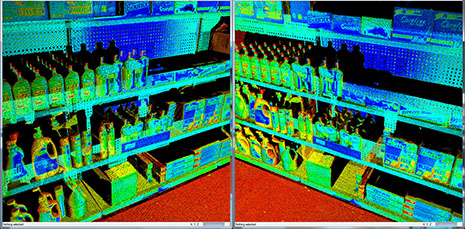University Centers Combine Efforts to Enhance Visual Identification Technologies

With visual identification technologies, a single 3-D data collection allows viewing and measurement from multiple viewpoints.
FAYETTEVILLE, Ark. – The RFID Research Center in the Sam M. Walton College of Business and the Center for Advanced Spatial Technologies (CAST) in the J. William Fulbright College of Arts and Sciences have partnered to conduct research that will integrate emerging visual identification technologies to use for retail applications.
The two University of Arkansas centers will also work together to develop standards for widespread adoption of the technologies.
Visual identification technologies (VIT) use inexpensive 2-D and 3-D imaging technologies, commonly found in cell phones and video game devices, to identify objects by color, shape and size without the need for traditional barcodes or product numbers. Products on store shelves or in warehouses can be recognized quickly and linked to product information databases. When linked to associated product information, the product can be added to inventory, verified for correct location and removed from inventory at checkout.
Visual identification technologies are becoming more common. People use these technologies everyday in video games that allow users to mimic dance moves and swing virtual tennis rackets.
“There are millions of devices in the hands of retailers and consumers across the United States today that can take a picture of an item – an apple or a detergent bottle, for example – send that picture to a server and then let software automatically identify the item,” said Justin Patton, managing director of the RFID Center. “The process is as simple as scanning a barcode, but it works from all angles and can capture many items at once. An image is enough, and the hardware is cheap.”
The university centers will collaborate on research to make visual identification technologies reliable for business applications, including identifying items missing from store shelves, speeding up self-checkout and locating items in distribution centers. The researchers will then work with global standards organizations to develop open standards that will allow for broad adoption.
“What is needed is a common digital data standard for shared items that can be used across platforms and amongst retailers,” said Jackson Cothren, associate professor of geosciences and director of CAST. “You can buy a bag of chips at a concert in Germany or at a gas station in New Mexico, and the standard VIT traits of that item are shared. This will have a major impact on the retail industry in the next three years.”
 Two views of a 3-D model created by a five-minute store scan. |
The RFID Research Center serves a large network of retailers and suppliers and has broad knowledge of store processes. The center has been successful at integrating new technology at large retailers such as Walmart, Dillard’s, JC Penney and Bloomingdale’s.
CAST has developed two-dimensional and three-dimensional analytics for geospatial location and mapping and shape analysis of natural and manmade objects. The center has developed digital standards for collecting and archiving of these data.
Together, the RFID Research Center and CAST have identified the most effective emerging technologies, all of which can be integrated with open databases to produce simple, fast and inexpensive visual identification technologies.
Preliminary research began in 2010 with early prototypes of Microsoft Kinect systems that can identify grocery items. The centers are now conducting studies on deep scans of actual store environments and within laboratory space at the RFID Research Center. The researchers have created 3-D models of the products and store environments comprised of billions of data points. They have begun to identify promising data that can be used to create a standard library of object information. Initial results will be issued in the fall of 2013.
Topics
Contacts
Justin Patton, managing director, RFID Research Center
Sam M. Walton College of Business
479-236-5890,
jpatton@walton.uark.edu
Jackson Cothren, director, CAST
J. William Fulbright College of Arts and Sciences
479-575-5421,
jcothre@uark.edu
Matt McGowan, science and research communications officer
University Relations
479-575-4246,
dmcgowa@uark.edu
Headlines
U of A Bands to Hold Three Nights of Concerts
The Symphonic Band, the Wind Symphony, the 4 O'Clock and 5 O'Clock Bands and the Wind Ensemble will perform April 21-23 at the Faulkner Performing Arts Center on the U of A campus.
Honors College to Host 'Best in Show' Dog Celebration
The campus and community are invited to celebrate our furry friends with popsicles, water and dog treats from 3-4 p.m. Thursday, April 25, in the Gearhart Courtyard.
New Parasite Affecting Canadian Partridges Named for Arkansas Poultry Scientist
A long-time colleague in Canada gave a newly found parasite the scientific name Eimeria hargisi in honor of U of A poultry science researcher Billy Hargis.
U of A School of Law Student Selected for Ms. J.D. Leadership Academy Intensive
Tristan Branstetter-Thomas, a second-year law student, was one of 30 students from across the country chosen to participate in the leadership academy at the Northwestern Pritzker School of Law in Chicago.
Needy Honored as Distinguished Alumna of University of Pittsburgh Engineering College
College of Engineering Dean Kim Needy was among seven alumni of the University of Pittsburgh Swanson School of Engineering honored in April as part of the 2024 Class of Distinguished Alumni.




